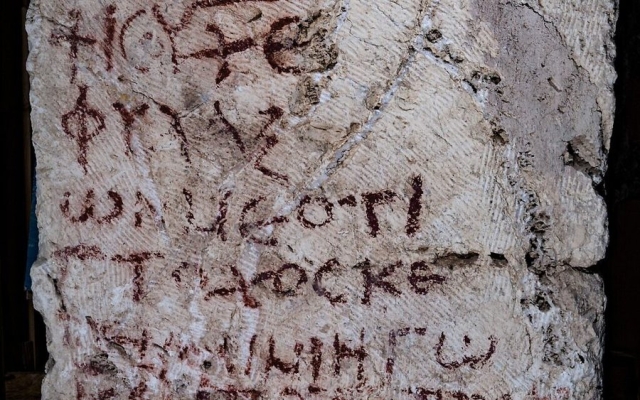A remarkable inscription in Greek, dating back to the Byzantine period, has been unearthed during excavations at the Horkania Fortress, an isolated archaeological site situated in the heart of the Judean desert. This exciting discovery sheds new light on the historical and cultural heritage of the region. The expedition, led by Dr. Oren Gutfeld and Michal Haber from the Hebrew University of Jerusalem, was initiated in response to the growing threat of antiquity thieves operating in the Judean desert.
The Horkania Fortress occupies a commanding position atop an isolated dome, towering approximately 250 meters above the Horkania Valley. It is situated some 17 kilometers southeast of Jerusalem and 8 kilometers southwest of Qumran. Despite sporadic tests and surveys conducted at the site over the years, a comprehensive scientific archaeological excavation had never been undertaken due to its location within a military zone and the challenging access routes.
ממצא נדיר אותר בירושלים: ניסוח מחודש לאחד ממזמורי תהיליםhttps://t.co/WK0tSGgdnU
— החדשות - N12 (@N12News) September 27, 2023
📷 שי הלוי, רשות העתיקות pic.twitter.com/uYBWXhQ1F6
The excavation efforts concentrated on two primary areas. In the southwestern section of the peak, archaeologists unveiled remnants of fortifications from the era of the Second Temple. These included a robust defensive wall and a watchtower. Dr. Gutfeld elaborated, "Within these fortifications, we observe architectural elements reminiscent of the design found at Herodion, reflecting a shared architectural vision—albeit on a smaller scale. It is conceivable that the same engineers and builders were involved. Horkania is rightfully dubbed 'the younger sibling of Herodion'."
In the northwestern portion of the mountain, the expedition confronted a formidable layer of collapsed building stones that had cascaded from the upper levels into a chamber within the basement of a sizable structure. Along the inner walls of this hall, columns adorned with art—typically featuring a square motif—were discovered, positioned opposite one another. This suggests the presence of arches that once supported the ceiling and upper levels of the monastery, remnants of which have unfortunately not survived.
During the excavation, a substantial stone masonry piece was unearthed, resting horizontally on the plain plaster floor of the hall. On it, in red ink, appeared nine or ten lines of text, crowned with a cross at the top. Haber and Dr. Gutfeld promptly recognized the script as Koine Greek, the language in which the New Testament was written. However, they sought the expertise of their colleague, epigrapher Dr. Avner Acker from Bar-Ilan University, to decipher the inscriptions. Based on their preliminary analysis (the concluding portion of the text is regrettably illegible), it seems that this is a paraphrase of Psalm 5.
While the original text of Psalm 5 reads, "A prayer of David. Hear, O LORD, and answer me, for I am poor and needy. Guard my life, for I am devoted to you," the discovered inscription renders it as follows: "Yazo Christo. Guard my life for I am poor and needy."
Dr. Ecker explained, "This particular psalm held immense significance in the ancient Christian liturgy. Evidently, one of the monks inscribed a cross on the wall and beneath it transcribed a prayer familiar to him. Judging by the style of the writing, the inscription dates back no later than the first half of the 6th century AD. Some syntactical errors in the transcription suggest that the writer was not a native Greek speaker but likely hailed from the region, possibly even a local resident, fluent in a Semitic language."
2,300-year-old tomb found in Israel may contain remains of Greek courtesan - CNN https://t.co/YSPlfnUHGJ
— Thomas Schemkes (@ThomasSchemkes) September 28, 2023
Bnei Har-Evan, the staff officer for archaeology in the Civil Administration of Judea and Samaria, shared his thoughts on the excavations at the site, stating, "The Civil Administration remains committed to the relentless preservation and advancement of archaeological sites throughout Judea and Samaria. Our collaboration with leading academic institutions in Israel, along with all stakeholders involved in the archaeology of the Land of Israel, aims to unveil the ancient and rich history of this region."


